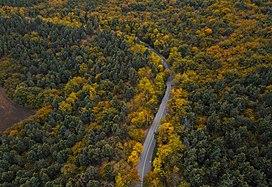
Back غابات هيركانيان Arabic Hirkan meşələri Azerbaijani হাইরক্যানিয়ান বন Bengali/Bangla Bosc mixt hircà del Caspi Catalan Hyrkánské lesy Czech Hyrkaniske skove Danish Hyrkanische Wälder German Hirkaniaj-kaspiaj miksaj arbaroj Esperanto Bosque mixto hircano del Caspio Spanish Kaspiar Baso misto hirkandarra Basque
| Caspian Hyrcanian mixed forests | |
|---|---|
 Sisangan National Forest, Mazandaran Iran | |
 Hyrcanian mixed forests (purple) | |
| Ecology | |
| Biome | Temperate broadleaf and mixed forests |
| Borders | |
| Bird species | 296[1] |
| Mammal species | 98[1] |
| Geography | |
| Area | 55,100 km2 (21,300 sq mi) |
| Countries |
|
| Conservation | |
| Habitat loss | 51%[1] |
| Protected | 10.30%[1] |
| Official name | Hyrcanian Forests |
| Criteria | Natural: (ix) |
| Designated | 2019 (43rd session) |
| Reference no. | 1584 |
| Region | Western Asia, Caucasus |
|
Preview warning: Page using Template:Infobox designation list with unknown parameter "buffer_zone" Preview warning: Page using Template:Infobox designation list with unknown parameter "Year" Preview warning: Page using Template:Infobox designation list with unknown parameter "area" | |
The Hyrcanian forests (Persian: جنگل های هیرکانی; Azerbaijani: Hirkan meşələri) are a zone of lush lowland and montane forests covering about 55,000 square kilometres (21,000 sq mi) near the shores of the Caspian Sea in Iran and Azerbaijan. The forest is named after the ancient region of Hyrcania. The World Wide Fund for Nature refers to the ecoregion as the Caspian Hyrcanian mixed forests. Since 5 July 2019, the Hyrcanian Forests have been designated a UNESCO World Heritage Site.[2] In September 2023, the heritage site expanded to incorporate portions of the forest located in Azerbaijan.[3]
- ^ a b c d Hoekstra, J. M.; Molnar, J. L.; Jennings, M.; Revenga, C.; Spalding, M. D.; Boucher, T. M.; Robertson, J. C.; Heibel, T. J.; Ellison, K. (2010). Molnar, J. L. (ed.). The Atlas of Global Conservation: Changes, Challenges, and Opportunities to Make a Difference. University of California Press. ISBN 978-0-520-26256-0.
- ^ "Iran's Hyrcanian Forests Added to UNESCO World Heritage List". Financial Tribune. 5 July 2019.
- ^ "Hyrcanian Forests". UNESCO World Heritage Centre. Retrieved 17 September 2023.